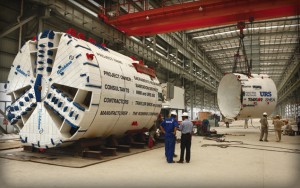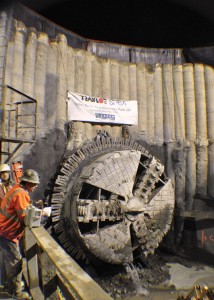![65 Years of Innovation and Experience [default]](https://www.robbinstbm.com/wp-content/uploads/2017/04/Side-Bar-Blue-Blocks_70-Years.jpg)
A Solution for Every Condition: Search our Project Database
Project Map
FEATURED PRODUCT: CROSSOVER MACHINES
Our History
A Legacy of Innovation
Information 24/7
News & Media
Insights in the Industry:
Read the Robbins Blog
 The Upper Northwest Interceptor (UNWI) sewer system in Sacramento, CA is comprised of nearly 30 km (18 mi) of tunnel. The system was created to ensure both present and future sewer needs are met, particularly during severe wet weather storms when existing systems are at risk of overflowing. The UNWI system was split up into nine sections with Section 1 starting in Natomas and Section 9 ending in Citrus Heights neighborhoods. Sections 3 through 9 were completed by 2008. The system is capable of conveying up to 560 million liters (148 million gallons) of wastewater per day.
The Upper Northwest Interceptor (UNWI) sewer system in Sacramento, CA is comprised of nearly 30 km (18 mi) of tunnel. The system was created to ensure both present and future sewer needs are met, particularly during severe wet weather storms when existing systems are at risk of overflowing. The UNWI system was split up into nine sections with Section 1 starting in Natomas and Section 9 ending in Citrus Heights neighborhoods. Sections 3 through 9 were completed by 2008. The system is capable of conveying up to 560 million liters (148 million gallons) of wastewater per day.
On August 22nd, 2007, Sacramento Regional County Sanitation District (SRCSD) awarded the USD $97.3 million construction contract to Traylor/Shea JV to complete Sections 1 & 2 of the UNWI Sewer Project. Traylor/Shea chose a 4.25 m (13.9 ft) Robbins EPB optimally designed for ground consisting of clay and running sand.
The Robbins EPBM was equipped with a spoke-type cutterhead and wear resistant cutterhead plates. Bentonite foam injection ports in the cutterhead allowed for stabilization of the tunnel face and smooth muck flow. Muck was removed using a 500 mm (20 in) diameter shaft-type screw conveyor emptying onto a Robbins continuous conveyor system. Two-component backfill grout was used to further stabilize ground behind segments, helping to reduce the risk of surface subsidence. The advantage of using a two-component grout was that the mixture could be pumped using a standard concrete pump, rather than the high-pressure pumps often needed with one-liquid concrete fills. By reducing the pump pressure, there was less chance of disturbing the surrounding soils.
The machine, which used active articulation rather than passive articulation, was able to negotiate curves down to a 400 m (1,300 ft) radius. Active articulation was chosen because it allows the front and rear shield to turn independently of the thrust cylinders, eliminating the common problem of ring deformation in curves.
 The EPB began boring in January 2009 from the New Natomas Pump Station. The tunnel profile below the spring line consisted mostly of sand, while the top part of the tunnel face was primarily in clay. The tunnel invert ranged from 7 to 14 m (23 to 46 ft) below the surface, with groundwater present throughout.
The EPB began boring in January 2009 from the New Natomas Pump Station. The tunnel profile below the spring line consisted mostly of sand, while the top part of the tunnel face was primarily in clay. The tunnel invert ranged from 7 to 14 m (23 to 46 ft) below the surface, with groundwater present throughout.
To shorten construction time, Traylor/Shea and the SRCSD wanted to use a new type of tunnel liner, one never before used in the United States. Precast concrete segments 228 mm (9 in) thick were molded with embedded PVC sheets 1.8 mm (0.07 in) thick. The PVC liner protects the concrete from degradation due to corrosive sewer gases. The final result is a finished tunnel that requires no final carrier pipe, reducing time for the pipeline to become functional.
Continuous conveyors were also chosen by Traylor/Shea due to the increased efficiency, reduced startup time, and higher availability than muck cars in most situations. The conveyor system was specially designed for the 5.7 km (3.6 mi) tunnel in varying ground conditions. Features included sealed transfer points and receiving hoppers, with urethane rubber being used to seal points and minimize spillage. The foam and bentonite additives helped maintain a smooth consistency of muck which flowed on the conveyor even when significant ground water was present.
Throughout the bore, the machine achieved some of the highest rates in soft ground TBM tunneling with multiple advances of 210 m (690 ft) per week, as well as daily rates of 50 m (165 ft) in three eight-hour shifts. In addition, the continuous conveyor system operated at over 90% availability for the duration of tunneling. Boring was completed on Nov. 21, 2009, when the Robbins EPBM broke through more than two months ahead of schedule.

 Close
Close